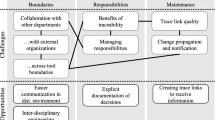Abstract
A critical factor in delivering quality software products is the quality of the software process. Software development is characterized by its multi-party activity (MPA), and a major challenge in managing the software process is the coordination of its constituent activities, resources and people. In this paper, we review approaches and techniques for managing multi-party activity in the software process in terms of their originating domain and the coordination features they address. Malone and Crowston's framework of coordination dependencies is adopted to consider common dependencies between activities and to classify the different approaches that have been taken to their management in software engineering. Some observations are made regarding strategies for achieving effective coordination and on areas for further investigation.
Similar content being viewed by others
References
T.W. Malone and K. Crowston. The interdisciplinary study of coordination. ACM Computing Surveys, 26(1), (1994) 87-119.
P. Rook. Controlling software projects. Software Engineering Journal, 1(1), (1986), 7-16.
G.D. Carter, C.P. Clare and D.C.J. Thorogood. Engineering project management techniques and their application to computer projects. Software Engineering Journal, 2(1), (1987), 15-20.
F.P. Brooks. The Mythical Man-month. Addison-Wesley, 1975.
F.T. Baker. Chief programmer team management of production programming, IBM Systems Journal, 11(1), (1972), 56-73.
Central Computer and Telecommunications Agency. PRINCE: Structured Project Management, NCC Blackwell, 1990.
E.H. Bersoff. Elements of software configuration management. IEEE Transactions on Software Engineering, 10(1), (1984), 79-87.
J.R. Cameron. An overview of JSD. IEEE Transactions of Software Engineering, 12(2), (1986), 222-240.
Yourdon Inc. Yourdon Systems Method. Yourdon Press, 1993.
Central Computer and Telecommunications Agency SSADM 4+: Version 4.2. NCC Blackwell, 1995.
J. Martin. Information Engineering Prentice-Hall, 1989.
P. Checkland and J. Scholes. Soft Systems Methodology in Action. John Wiley & Sons, 1990.
J.E. Cooling. Software Design for Real-time Systems Chapman and Hall, 1991, pp. 331-344.
A. Finkelstein, J. Kramer, B. Nuseibeh, L. Finkelstein and M. Goedicke. Viewpoints: a framework for integrating multiple perspectives in system development. International Journal of Software Engineering and Knowledge Engineering, 2(1), (1992), 31-57.
I.R. McChesney, D. Glass and J.G. Hughes. CASE tool support for requirements capture and analysis, Microprocessing and Microprogramming, 30, September (1990), 281-288.
P. Lempp. Integrated computer support in the software engineering environment EPOS - possibilities of support in system development projects. In Proceedings 12 th Symposium on Microprocessing and Microprogramming,Venice, 1986, pp. 223-232 (North-Holland).
M.J Rochkind. The source code control system. IEEE Transactions on Software Engineering, 1(4), (1975), 364-370.
Digital Equipment Corporation. Guide to VAX DEC/Code Management System 1989.
Intersolv. PVCS.http://www.intersolv.com/solution/scm_top.htm, 1996.
R.M. Greenwood. Coordination theory and software process technology. In Proceedings 4 th European Workshop of Software Process Technology (EWSPT'95), (ed. W. Schafer) Lecture Notes in ComputerScience, Vol 913, Springer-Verlag, 1995.
L.J. Osterweil. Software processes are software too. In Proceedings 9 th International Conference Software Engineering, Monterey, California, April 1987, pp 2-13 (IEEE CS Press).
S.M. Sutton Jr., H. Ziv, D. Heimbigner, H.E. Yessayan, M. Maybee, L.J. Osterweil and X. Song. Programming a software requirements specification process. In Proceedings 1 st International Conference Software Process, Redondo Beach, California, October 1991, pp. 68-89 (IEEE CS Press).
Y. Matsumoto, K. Agusa and T.A. Ajisaka. A software process model based on unit workload network. In Proceedings 5 th International Software Process Workshop, Kennebunkport, Maine, October 1989, pp. 64-66 (IEEE CS Press).
W. Deiters and V. Gruhn. Software process analysis based on FUNSOFT nets. Systems Analysis Modelling Simulation, 8(4), (1991), 315-325.
S.C. Bandinelli, A. Fuggetta and C. Ghezzi. Software process model evolution in the SPADE environment. IEEE Transactions of Software Engineering, 19(12), (1993), 1128-1144.
M.I. Kellner, (1991). Software process modelling support for management planning and control. In Proceedings 1 st International Conference Software Process, Redondo Beach, California, October 1991, pp. 8-28 (IEEE CS Press).
M. Dowson. Integrated project support with IStar. IEEE Software, 4(11), (1987), 6-15.
K.E. Huff and V.R. Lesser. A plan-based intelligent assistant that supports the software development process. ACM SIGSOFT Soft Eng. Notes, 13(5), (1988), 97-106.
M.H. Penedo and C. Shu. Acquiring experiences with the modelling and implementation of the project life-cycle process: the PMDB work. Software Engineering Journal, 6(5), (1991), 259-274.
N. Belkhatir, J. Estublier and W.L. Melo. Software process model and work space control in the Adele system. In Proceedings 2 nd International Conference Software Process, Berlin, Germany, February 1993, pp. 2-11 (IEEE CS Press).
M.C. Paulk, B. Curtis, M.B. Chrissis and C.V. Weber. Capability Maturity Model for Software, Version 1.1, Technical Report CMU/SEI-93-TR-24, 1993 (Software Engineering Institute, Carnegie Mellon University, Pittsburgh, PA).
I.R. McChesney. Toward a classification scheme for software process modelling approaches. Information and Software Technology, 37(7), 1995, 363-374.
I.R. McChesney. Modelling multi-party activity in the IS process from a language/action perspective. Proceedings Fourth International Conference on Information Systems Development - ISD'94, Bled, Sovenia, September 1994, pp. 53-62.
Author information
Authors and Affiliations
Rights and permissions
About this article
Cite this article
McChesney, I. Effective coordination in the software process - historical perspectives and future directions. Software Quality Journal 6, 235–246 (1997). https://doi.org/10.1023/A:1018568220273
Issue Date:
DOI: https://doi.org/10.1023/A:1018568220273




